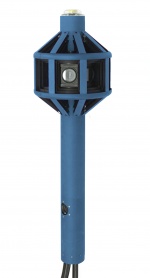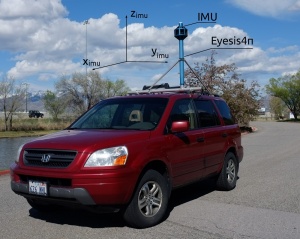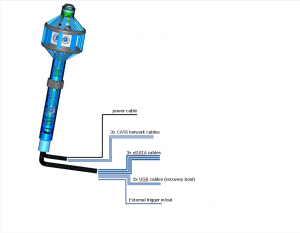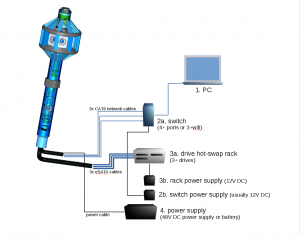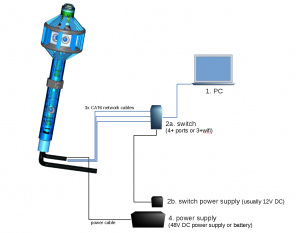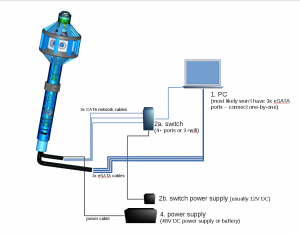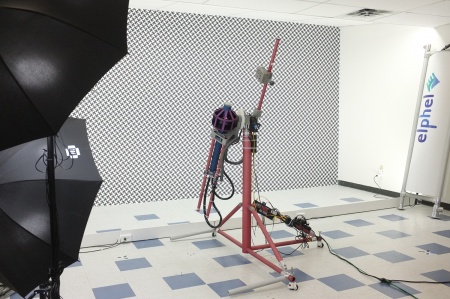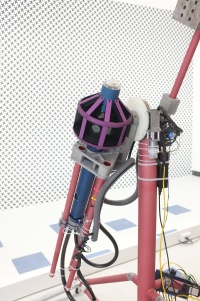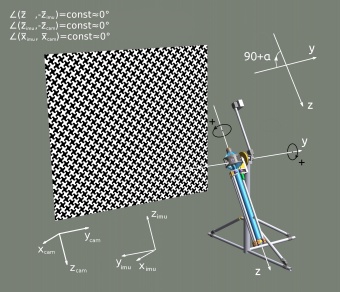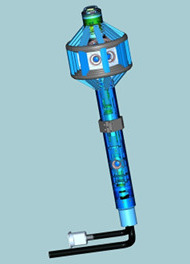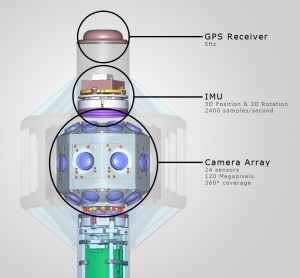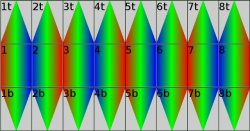Difference between revisions of "Eyesis4Pi 393"
(→Links) |
|||
| (16 intermediate revisions by 3 users not shown) | |||
| Line 20: | Line 20: | ||
<sup>*</sup> ''Car and backpack mounts are not included.'' | <sup>*</sup> ''Car and backpack mounts are not included.'' | ||
| − | ====Improvements over | + | ====Improvements over the earlier generation [[Eyesis4Pi]]==== |
* new [[10393]] system boards | * new [[10393]] system boards | ||
| − | ** faster recording | + | ** compressor bandwidth: 1 GPix/s vs. 85 MPix/s |
| − | ** | + | ** only 3 system boards needed to support all 26 sensors vs. 9 |
| − | * more compact | + | ** contemporary OpenEmbedded Linux OS |
| − | * | + | ** full 5 FPS at high quality vs. 2 FPS |
| + | ** faster recording speed: 220 MB/s x 3 vs. 16 MB/s x 9 | ||
| + | ** Gigabit Ethernet vs. 100 MB | ||
| + | * more compact | ||
| + | * more lightweight | ||
|} | |} | ||
| Line 31: | Line 35: | ||
* 4*π (360x180) full sphere coverage | * 4*π (360x180) full sphere coverage | ||
* 64 MPix panoramic image resolution after stitching | * 64 MPix panoramic image resolution after stitching | ||
| − | * Final panoramic image equirectangular projection dimensions - | + | * Final panoramic image equirectangular projection dimensions - 14268x7135 |
* 0.05 Pix stitching precision | * 0.05 Pix stitching precision | ||
* Very small parallax - distance between entrance pupils: 46.5 mm | * Very small parallax - distance between entrance pupils: 46.5 mm | ||
| Line 57: | Line 61: | ||
* The Eyesis4Pi-393 system is highly customizable | * The Eyesis4Pi-393 system is highly customizable | ||
* Free Software and Open Hardware | * Free Software and Open Hardware | ||
| + | |||
| + | == Image samples == | ||
| + | * Post-processing results (equirectangular projections) and demos: | ||
| + | ** [[Eyesis4Pi_samples|<span style='font-size:14px;'>'''Samples page'''</span>]] | ||
| + | |||
| + | {| | ||
| + | |[[File:Result 1342929037 024522.jpeg|400px|link=Eyesis4Pi_samples]] | ||
| + | |[[File:Result 1342929037 024522 webgl.jpeg|206px|link=Eyesis4Pi_samples]] | ||
| + | |} | ||
==Operation== | ==Operation== | ||
| − | * The system is controlled from a laptop via a [[ | + | * The system is controlled from a laptop via a [[Eyesis4Pi_393_User_Guide_-_Recording|web-based interface (Eyesis4Pi GUI)]]. Which also displays real-time previews and parameters. |
* Power consumption is about 50W. | * Power consumption is about 50W. | ||
* Power supply: | * Power supply: | ||
** AC/DC power adapter (input: 110V/220V, output: 48V 2A) and can be used with a car power adapter (inverter), when mounted on a car roof. | ** AC/DC power adapter (input: 110V/220V, output: 48V 2A) and can be used with a car power adapter (inverter), when mounted on a car roof. | ||
| − | ** 48V batteries (48V 4Ah - about | + | ** 48V batteries (48V 4Ah - about 1-2 hours of operation) |
{| style='padding:0px;' | {| style='padding:0px;' | ||
| Line 93: | Line 106: | ||
==Software== | ==Software== | ||
| − | All software is FOSS (Free and Open Source Software). It is experimental software that is used to test the camera performance, and it continues to be developed. All updates are available for download and build from https:// | + | All software is FOSS (Free and Open Source Software). It is experimental software that is used to test the camera performance, and it continues to be developed. All updates are available for download and build from [https://git.elphel.com/Elphel Elphel Git]. Software may require integration with customer software depending upon camera hardware configuration and application. It includes: |
* Camera internal software/firmware and SDK | * Camera internal software/firmware and SDK | ||
* Post-processing tools | * Post-processing tools | ||
* Calibration data | * Calibration data | ||
| + | |||
| + | ==Workflow and user guides== | ||
| + | [[Eyesis4Pi_393_workflow|'''More info''']] | ||
==3D Model== | ==3D Model== | ||
| Line 103: | Line 119: | ||
{| border="0" cellpadding="3" style="border:1px solid lightgray;border-collapse:collapse;" | {| border="0" cellpadding="3" style="border:1px solid lightgray;border-collapse:collapse;" | ||
|- | |- | ||
| − | | <span class="plainlinks" title="View model in the Web X3D Viewer">[ | + | | <span class="plainlinks" title="View model in the Web X3D Viewer">[https://community.elphel.com/x3d/index.html?nobuttons&animate&model=/x3d/x3d_model_files/x3d/EYESIS4PI-26-393-ASSY.x3d https://community.elphel.com/pictures/eyesis4pi/EYESIS4PI-26-393_resized_2.jpeg]</span> |
|- | |- | ||
| − | | [ | + | | [https://community.elphel.com/x3d/index.html?nobuttons&animate&model=/x3d/x3d_model_files/x3d/EYESIS4PI-26-393-ASSY.x3d Eyesis4PI-26-393 3D] |
|} | |} | ||
|} | |} | ||
| Line 124: | Line 140: | ||
*Toll-free: (888) 3 ELPHEL | *Toll-free: (888) 3 ELPHEL | ||
*Fax: (801) 812-8267 | *Fax: (801) 812-8267 | ||
| + | |||
| + | == Links == | ||
| + | |||
| + | *[[Eyesis4Pi_393|Eyesis4Pi 393 Main Article]] | ||
| + | *[[Eyesis4Pi_393_workflow|Workflow]] | ||
| + | *[[Eyesis4Pi_393_User_Guide_-_Recording|User Guide: Recording]] | ||
| + | *[[Eyesis4Pi_393_Downloading_footage|User Guide: Downloading footage]] | ||
| + | *[[Eyesis4Pi_393_Footage_Procedures_page|User Guide: Post-Processing selected few panoramas]] | ||
| + | *[[Eyesis4pi Post-Processing|User Guide - Post-processing: ImageJ]] | ||
| + | *[[Eyesis4Pi data structure|Data Structure Description]] | ||
| + | *[[Eyesis4Pi Calibration|Calibration Process]] | ||
| + | [[Category:Eyesis4Pi393]] | ||
Latest revision as of 15:08, 24 April 2017
Contents
Status
Available
Overview
Elphel Eyesis4Pi-26-393 is the newer generation of the full-sphere multi-camera systems for stereophotogrammetric applications.
Automated panoramic imagery and 3-dimensional panoramas are the 2 main applications of Eyesise4Pi-393 camera. * Car and backpack mounts are not included. Improvements over the earlier generation Eyesis4Pi
|
Features and Specs
- 4*π (360x180) full sphere coverage
- 64 MPix panoramic image resolution after stitching
- Final panoramic image equirectangular projection dimensions - 14268x7135
- 0.05 Pix stitching precision
- Very small parallax - distance between entrance pupils: 46.5 mm
- High resolution lenses: 26x M12 lens mount
- Calibrated fixed lens to compensate for the lenses distortions
- 10" (0.1 pix) in the center 80% x 80% area
- 30" (0.3 pix) maximal error over the full FoV
- <0.03um/° thermal expansion
- Precise image capture synchronization
- 5 FPS - maximum frame rate
- RAW or compressed image formats
- Images are geo-tagged (Exif) - 5Hz GPS receiver (Locosys LS20031)
- High-precision IMU ADIS 16375
- Recording to:
- internal SSDs - not swappable - 3x m.2 SSDs (physical size: 2242 or 2260)
- external SSDs - swappable - 3x 2.5" SSDs connected in a hot swap rack
- PC over network
- Web Based GUI
- SYNC cable allows:
- receive and log external trigger (from a sensor such as odometer or extra GNSS system)
- generate output signal to trigger other sensors or cameras
- Weatherproof camera body and camera pole
- Dimensions: 230x760 mm (9x30")
- Weight: 8 kg (18 lbs)
- The Eyesis4Pi-393 system is highly customizable
- Free Software and Open Hardware
Image samples
- Post-processing results (equirectangular projections) and demos:
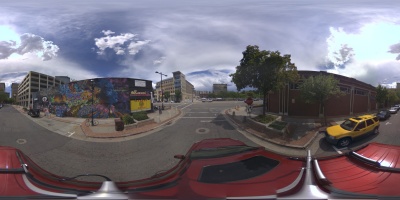
|
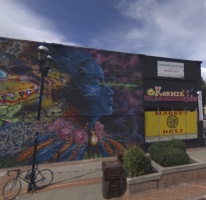
|
Operation
- The system is controlled from a laptop via a web-based interface (Eyesis4Pi GUI). Which also displays real-time previews and parameters.
- Power consumption is about 50W.
- Power supply:
- AC/DC power adapter (input: 110V/220V, output: 48V 2A) and can be used with a car power adapter (inverter), when mounted on a car roof.
- 48V batteries (48V 4Ah - about 1-2 hours of operation)
Calibration
We have developed full calibration process and post-processing software to compensate for:
- Optical aberrations, allowing to preserve full sensor resolution over the camera FoV.
- Distortions – for precise pixel-mapping for photogrammetry and 3D reconstruction.
The calibration is performed using the machine (goniometer) that rotates the camera about 2 axes by precisely known angles. To calibrate IMU one needs to match the goniometer angles with the IMU data.
Check out these articles for more details:
Software
All software is FOSS (Free and Open Source Software). It is experimental software that is used to test the camera performance, and it continues to be developed. All updates are available for download and build from Elphel Git. Software may require integration with customer software depending upon camera hardware configuration and application. It includes:
- Camera internal software/firmware and SDK
- Post-processing tools
- Calibration data
Workflow and user guides
3D Model
|
More information
How to buy
We are directly accepting orders and ship worldwide. Please contact Elphel for Lead Time and Quotes:
- Email (Sales Inquiry): sales@elphel.com
- Phone: (801) 783-5555 x 107
- Toll-free: (888) 3 ELPHEL
- Fax: (801) 812-8267

